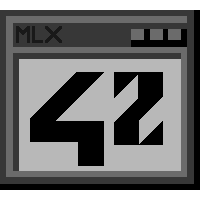Drawing to a window
✏️ Drawing pixels
Now that we have basic window management, we can get started with drawing pixels to the window.
To do so you can use mlx_pixel_put by giving it your mlx pointer, your window pointer, coordinates where to draw it and its color (see colors to learn about mlx_color):
#include "MacroLibX/includes/mlx.h"
int main(void){ mlx_context mlx = mlx_init();
mlx_window_create_info info = { 0 }; info.title = "Hello World!"; info.width = 400; info.height = 400; mlx_window win = mlx_new_window(mlx, &info);
mlx_pixel_put(mlx, win, 10, 10, (mlx_color){ .rgba = 0xFF0000FF }); // draws a red pixel at x,y = 10,10
mlx_loop(mlx);
mlx_destroy_window(mlx, win); mlx_destroy_context(mlx);}You can use it to draw as much pixels as you want
#include "MacroLibX/includes/mlx.h"
int main(void){ mlx_context mlx = mlx_init();
mlx_window_create_info info = { 0 }; info.title = "Hello World!"; info.width = 400; info.height = 400; mlx_window win = mlx_new_window(mlx, &info);
for(int i = 0; i < 100; i++) { for(int j = 0; j < 100; j++) mlx_pixel_put(mlx, win, i, j, (mlx_color){ .rgba = 0xFF0000FF }); }
mlx_loop(mlx);
mlx_destroy_window(mlx, win); mlx_destroy_display(mlx);}By including mlx_extended.h you also get access to mlx_pixel_put_array and mlx_pixel_put_region.
The first one lets you put an array of pixels contiguously. The second one lets you put a squared region of pixels.
#include "MacroLibX/includes/mlx.h"#include "MacroLibX/includes/mlx_extended.h"
int main(void){ mlx_context mlx = mlx_init();
mlx_window_create_info info = { 0 }; info.title = "Hello World!"; info.width = 400; info.height = 400; mlx_window win = mlx_new_window(mlx, &info);
mlx_color pixels[40 * 40] = { 0 }; int i = 0; for(int y = 0; y < 40; y++) { for(int x = 0; x < 40; x++, i++) pixels[i].rgba = 0xFF0000FF; }
mlx_pixel_put_array(mlx, win, 20, 20, pixels, 40 * 40); // Will put all pixels next to each other
mlx_pixel_put_region(mlx, win, 100, 100, 40, 40, pixels); // Will put a square of 40x40 pixels at 100:100
mlx_loop(mlx);
mlx_destroy_window(mlx, win); mlx_destroy_display(mlx);}🏙️ Drawing images
The MacroLibX is also capable of loading and rendering images from disk. It accepts PNGs, JPEGs, and BMPs. The difference with put pixel is that the image is a resource and must be destroyed when it is no longer needed.
#include "MacroLibX/includes/mlx.h"
int main(void){ mlx_context mlx = mlx_init();
mlx_window_create_info info = { 0 }; info.title = "Hello World!"; info.width = 400; info.height = 400; mlx_window win = mlx_new_window(mlx, &info);
int img_width; int img_height; mlx_image img = mlx_new_image_from_file(mlx, "path/to/my/awesome/image.png", &img_width, &img_height);
mlx_put_image_to_window(mlx, win, img, 42, 42); // displays the image at x,y = 42,42
mlx_loop(mlx);
// do not forget to destroy the image, otherwise the MacroLibX will yell at you ! mlx_destroy_image(mlx, img); mlx_destroy_window(mlx, win); mlx_destroy_context(mlx);}We’ll see later how we can create empty images and how to manipulate them.
By including mlx_extended.h you also get access to mlx_put_transformed_image_to_window.
This one lets you put an image to a window and transform how it appears by scaling it or rotating it.
#include "MacroLibX/includes/mlx.h"#include "MacroLibX/includes/mlx_extended.h"
int main(void){ mlx_context mlx = mlx_init();
mlx_window_create_info info = { 0 }; info.title = "Hello World!"; info.width = 400; info.height = 400; mlx_window win = mlx_new_window(mlx, &info);
int img_width; int img_height; mlx_image img = mlx_new_image_from_file(mlx, "path/to/my/awesome/image.png", &img_width, &img_height);
// displays the image at 42:42, scaling its width by half and doubling its height and rotating it by 75 degrees clockwise mlx_put_transformed_image_to_window(mlx, win, img, 42, 42, 0.5f, 2.0f, 75.0f);
mlx_loop(mlx);
// do not forget to destroy the image, otherwise the MacroLibX will yell at you ! mlx_destroy_image(mlx, img); mlx_destroy_window(mlx, win); mlx_destroy_context(mlx);}